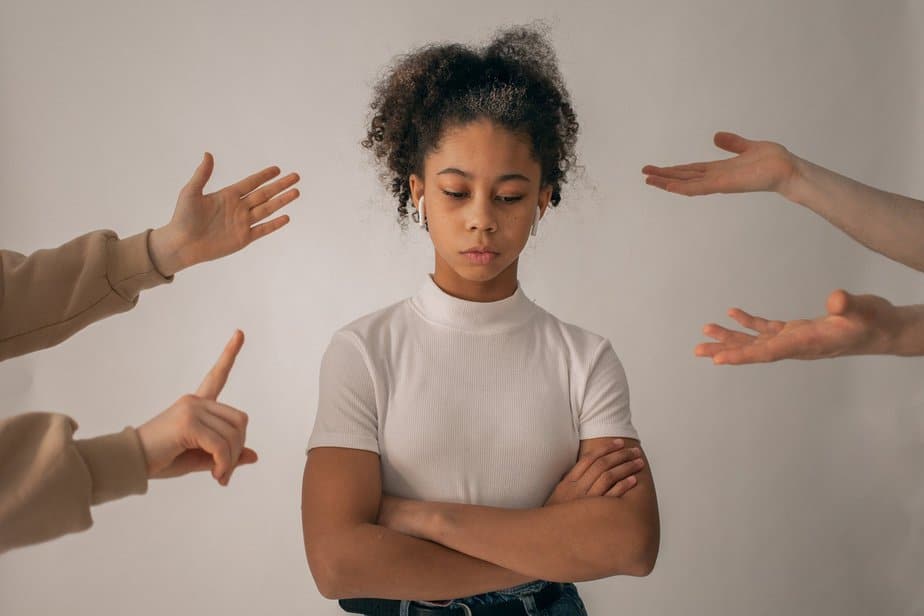10 Negative Body Language Signs And How To Avoid Them

Communication consists of far more than the words we say. Sure, we communicate with our words, but we also send silent signals with our postures, gestures, and facial expressions. With poor non-verbal cues, we could damage our relationships. How can we recognize negative body language signs, though?
When you interact with people, whether you’re on a date, in a business meeting, or on the street, you showcase a myriad of patterns, signs, and cues that communicate how you’re feeling or what you’re thinking at that moment. Consciously or subconsciously, your body gives everything away.
Negative body language can wreak havoc within relationships by offending, turning off, or even alienating the people you’re closest to. Without even knowing, you might be sending the wrong message. Keeping your body language in check can be challenging, but that’s why we’re here.
What is body language, and why is it important?

We’re pretty sure you’ve experienced situations where you’ve successfully gauged a friend’s or stranger’s mood by analyzing their gestures and/or facial expressions. Well, there you go, you’ve read their body language. Body language refers to non-verbal cues people use to communicate.
Whether negative or positive, body language offers some sort of context to whatever you’re talking about. The words you use make up your verbal communication. The facial expressions, hand gestures, mannerisms, physical behavior, and tone of voice make up your non-verbal communication.
More times than not, non-verbal communication, or body language, communicates more than the words you use. When your significant other asks you “Are you okay?” and you respond with “Yes, I’m fine!” while frowning, looking at the floor, and avoiding eye contact, you’re communicating something other than fine with your body.
Why do you need to get better at expressing and reading body language signs and signals? Body language might be one of the primary ways we communicate. When you become better at body language, you become a better communicator.
Positive body language has the power to create relationships, but negative body language has the power to break them. What are negative body language signs you might be unconsciously employing and how to avoid them? We’re bringing you all that and more down below!
10 negative body language signs that send the wrong message
1. Poor posture
Proper posture can change the way you approach people, as well as the way people respond to you. When you slouch, cross your arms, or turn away from people when you’re talking to them, you risk looking disinterested, defensive, and borderline bored.
When you stand up or sit up straight, look at people with a smile on your face, and keep your arms slightly open, you’re telling them that you’re approachable, open to conversation, and happy to talk to them. With a few tweaks, you can change the entire course of the conversation.
2. Lack of eye contact

We don’t even need to explain why maintaining eye contact changes the way people respond to you and to whatever you’re saying. When you’re trying to close a business deal, for example, and you keep looking down at your feet or looking away from the person you’re talking to, they might think you’re untrustworthy.
If you’re making eye contact with another person, looking around the room, or looking into space, you’re being disrespectful to the person you’re talking to. You look like you’re bored or hoping to escape the conversation.
You can do better!
3. Negative facial expressions
Frowning, scowling, or eye-rolling aren’t welcome, that’s for sure. Whether you’re in the workplace, on a date, or somewhere where you want to leave a good impression, you need to be conscious of the faces you’re making.
We’re all blissfully unaware of the faces we make when we’re focusing on something, but that doesn’t mean that we’re allowed to lose control over our own faces. Smile politely, nod at the person you’re talking to, or keep a neutral expression when you’re unsure of how to respond to something.
4. Weak or repetitive gestures
Whenever we’re nervous or experiencing stage fright, we forget how to behave, how to stand, or even what to do with our hands. When you go through something of the sort, don’t freak out. Remember to match your gestures to your words and you’re good to go.
Certain gestures are considered aggressive and might not be the best way to go when you’re trying to make a good impression.
Finger-pointing, crossed arms, or excessive hand movements can convey the wrong message and make people think you’re attacking them, accusing them of something, or even poking fun at them.
5. Lack of active listening

We’ve all been in scenarios where we wanted to depart early from boredom or react aggressively because we were fed up with whatever we were exposed to. Whenever you’re having a conversation with someone, you’re expected to listen and actively participate.
Rather than checking your watch every two or three minutes or, God forbid, interrupting the person you’re talking with, try masking the signs of impatience. Maintain eye contact, add meaningful insights into the topic of conversation, and steer the conversation in the right direction.
Doing otherwise can make others feel undervalued, disrespected, or unheard.
6. Poor use of space
Now we’re getting into the nitty-gritty of non-verbal communication. Poor use of space might not matter when you’re hanging out with friends or throwing a Sunday barbecue for the closest members of your family.
When you’re surrounded by people who know you, you don’t need to put on a show. But when you’re struggling with non-verbal communication in the workplace, for instance, you might want to work on your use of space.
Whether you’re giving a presentation or organizing some sort of workshop, you need to figure out a way to use body language to command space. When you do that, you’re sending the message that you’re confident and comfortable, and you know what you’re talking about.
7. Touching or fixing your hair
Touching or fixing your hair isn’t the worst thing you can do when you’re in a casual setting. Although you’re likely sending the message that you’re nervous or unsure of what to do with your hands, there’s nothing inappropriate about this.
Workplaces are a different story, though. When you’re talking to your boss, attending a meeting, or talking to someone who holds some sort of authority over you, you might not want to appear nervous, distracted, or unsure. Find a different way to entertain your fingers.
8. Covering your mouth

We’ve all experienced conversations where we’ve been so taken aback by the gossip or the sheer amount of information we’re presented with, we didn’t know how else to react but to cover our mouths. And there’s nothing wrong with that.
When you cover your mouth in the wrong setting, though, you might convey that you’re caught off guard. It might also show that you’re struggling with a lack of confidence, covering a yawn, or masking your facial expressions.
9. Using the word “but”
Okay, so this isn’t technically body language, but it deserves a spot on this list. Now, that doesn’t mean that you’re not allowed to use the word “but” ever again.
When you’re talking to someone, and you need to point out a contrast between two things, you might use the word “but.” Things can get messy, though, when you use that word to make an excuse for something that you shouldn’t make an excuse for.
“I’m really sorry that I didn’t finish the task on time, but you know how busy I’ve been these days.”
“Oh, I didn’t mean to forget about your birthday, but I’ve been dealing with so many things on my mind.”
When you’re apologizing for something you did, you need to own up to your mistakes and make sure the person knows you’re never going to do that again. When you come up with excuses, you’re putting the blame on something or someone else rather than accepting your part in whatever went down.
10. Too weak or too strong of a handshake

With the right handshake, you can influence the way someone feels about you within the first few seconds of knowing them. Handshakes are often the first impression someone has of you, and that’s why they’re one of the most important tools of body language.
Too weak of a handshake signals that you’re either struggling with confidence or disinterested in meeting the person you’re shaking hands with. Too strong of a handshake, on the other hand, signals that you’re aggressive, and you have no regard for the person.
When you find the happy medium between the two, you’ll master the art of handshaking.






